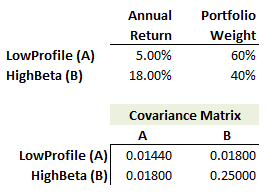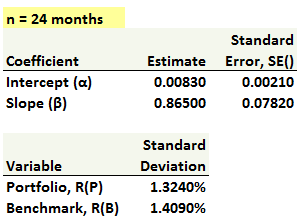Questions:
6. The following parameters have been estimated for a GARCH(1,1) model which gives an estimate of today's daily volatility (today = day n):

Yesterday's (n-1) daily volatility was 2.0% and yesterday's daily return was -7.0%. What is the GARCH(1,1) estimate of the daily volatility in 20 days (that is, the estimated volatility on day n+20)?
a. 1.50%
b. 2.85%
c. 3.91%
d. 4.23%
7. Let B and Y represent random normal variables: B ~ N(300, 200^2) and Y ~ N(200,150^2). Let A characterize the average of a random sample of 100 draws (trials) from B, and let X characterize the average of a random sample of 100 draws from Y. We can assume that A and X are independent. What is the joint probability Pr[ A < 253.40, X < 170.60]?
a. 0.050%
b. 0.225%
c. 0.667%
d. 1.305%
8. A stock has a price today of $52.00, an expected return of 14.0% per annum and a volatility of 36.0% per annum. We assume the stock's stochastic process is a geometric Brownian motion (GBM) with a consequent lognormal price distribution. What is the 95.0% confidence interval for the stock price in three months (today + 0.25 years), if we are careful to use the geometric return, which erodes the drift by one-half the variance (i.e., the geometric return is necessarily less than the arithmetic return for any nonzero volatility)?
a. $29.54 < S(0.25) < $121.13
b. $37.24 < S(0.25) < $75.40
c. $45.33 < S(0.25) < $67.18
d. $49.60 < S(0.25) < $60.22
9. A portfolio holds two securities, LowProfile(A) and HighBeta(B). The expected annual returns, weights, and covariance matrix are given by the following:

The security returns are normally distributed and independent over time (i.e., zero autocorrelation). If the portfolio value is $10.0 million and we assume 250 trading days per year, which is nearest to the 10-day 99.0% relative portfolio value at risk (VaR)?
a. $323,700
b. $716,490
c. $1,080,000
d. $3,065,250
10. A portfolio manager regressed two years of monthly excess portfolio returns, R(P), against the excess returns of the index benchmark, R(B). The sample includes 24 months, n =24. The resulting regression, see below, is R(P,i) = 0.00830 + 0.86500*R(B,i) + e(i).

The portfolio manager infers the following from the regression results:
I. The intercept is significantly different than zero with 95% confidence
II. The slope is significantly different than 1.0 with 95% confidence
III. Assuming the total sum of squares (TSS) is 0.00420, the standard error of the regression (SER) is ~ 1.1940
IV. The coefficient of determination (R^2) is ~ 0.8474
Which of the statements is (are) correct?
a. None
b. I. and IV. only
c. II. and III. only
d. All are correct
Answers:
6. The following parameters have been estimated for a GARCH(1,1) model which gives an estimate of today's daily volatility (today = day n):

Yesterday's (n-1) daily volatility was 2.0% and yesterday's daily return was -7.0%. What is the GARCH(1,1) estimate of the daily volatility in 20 days (that is, the estimated volatility on day n+20)?
a. 1.50%
b. 2.85%
c. 3.91%
d. 4.23%
7. Let B and Y represent random normal variables: B ~ N(300, 200^2) and Y ~ N(200,150^2). Let A characterize the average of a random sample of 100 draws (trials) from B, and let X characterize the average of a random sample of 100 draws from Y. We can assume that A and X are independent. What is the joint probability Pr[ A < 253.40, X < 170.60]?
a. 0.050%
b. 0.225%
c. 0.667%
d. 1.305%
8. A stock has a price today of $52.00, an expected return of 14.0% per annum and a volatility of 36.0% per annum. We assume the stock's stochastic process is a geometric Brownian motion (GBM) with a consequent lognormal price distribution. What is the 95.0% confidence interval for the stock price in three months (today + 0.25 years), if we are careful to use the geometric return, which erodes the drift by one-half the variance (i.e., the geometric return is necessarily less than the arithmetic return for any nonzero volatility)?
a. $29.54 < S(0.25) < $121.13
b. $37.24 < S(0.25) < $75.40
c. $45.33 < S(0.25) < $67.18
d. $49.60 < S(0.25) < $60.22
9. A portfolio holds two securities, LowProfile(A) and HighBeta(B). The expected annual returns, weights, and covariance matrix are given by the following:

The security returns are normally distributed and independent over time (i.e., zero autocorrelation). If the portfolio value is $10.0 million and we assume 250 trading days per year, which is nearest to the 10-day 99.0% relative portfolio value at risk (VaR)?
a. $323,700
b. $716,490
c. $1,080,000
d. $3,065,250
10. A portfolio manager regressed two years of monthly excess portfolio returns, R(P), against the excess returns of the index benchmark, R(B). The sample includes 24 months, n =24. The resulting regression, see below, is R(P,i) = 0.00830 + 0.86500*R(B,i) + e(i).

The portfolio manager infers the following from the regression results:
I. The intercept is significantly different than zero with 95% confidence
II. The slope is significantly different than 1.0 with 95% confidence
III. Assuming the total sum of squares (TSS) is 0.00420, the standard error of the regression (SER) is ~ 1.1940
IV. The coefficient of determination (R^2) is ~ 0.8474
Which of the statements is (are) correct?
a. None
b. I. and IV. only
c. II. and III. only
d. All are correct
Answers:
